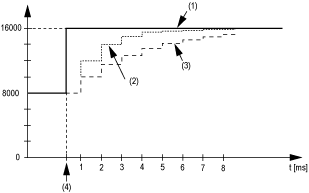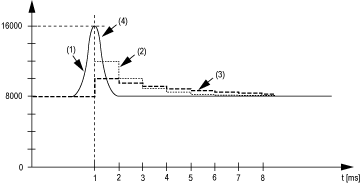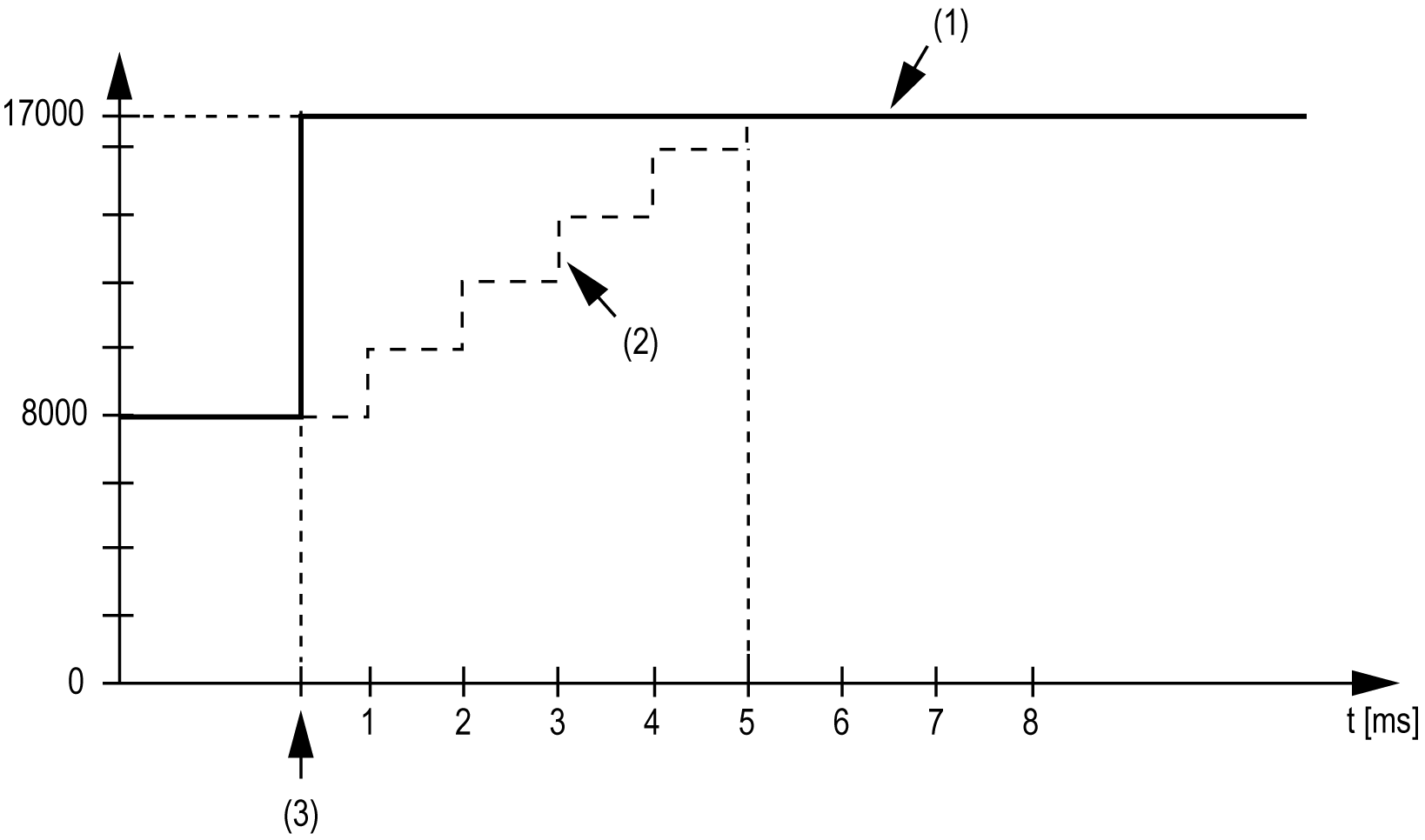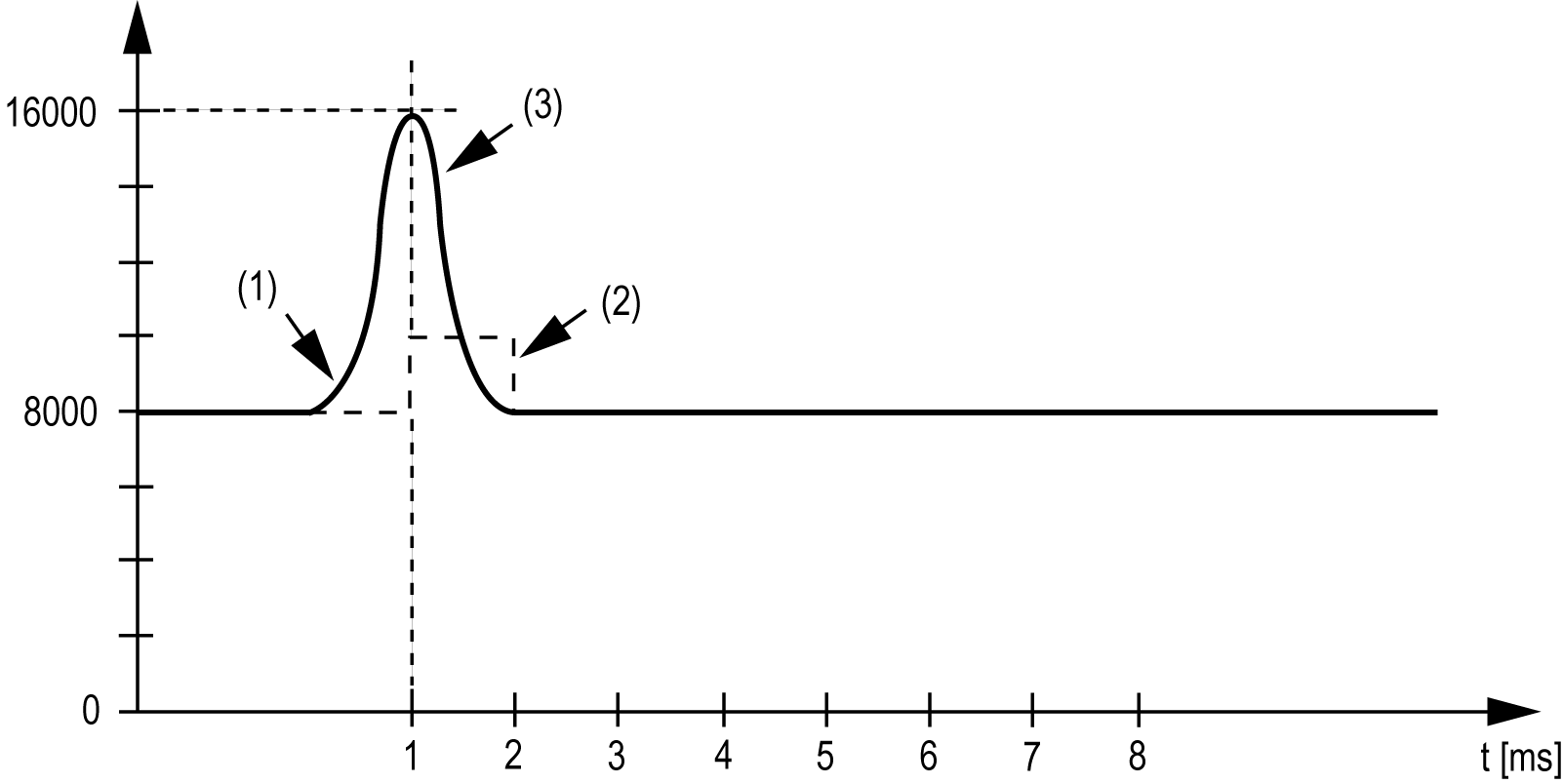AI4LE Embedded Regular I/O Module
The AI4LE embedded regular I/O module is a ±10 Vdc/0...20 mA/4...20 mA analog input module with 4 inputs.
If you have wired your input for a voltage measurement, and you configure EcoStruxure Machine Expert for a current type of measurement (or vice-versa), you may permanently damage the electronic module.
|
NOTICE |
|
INOPERABLE EQUIPMENT |
|
Verify that the physical wiring of the analog circuit is compatible with the software configuration for the analog channel. |
|
Failure to follow these instructions can result in equipment damage. |
The table below describes the modules parameters configuration:
|
Parameter |
Value |
Default Value |
Description |
|
|---|---|---|---|---|
|
General |
Lower limit |
-32768...32767 |
-32767 |
Specifies the lower measurement limit |
|
Upper limit |
-32768...32767 |
32767 |
Specifies the upper measurement limit |
|
|
Input filter |
Off level 2 level 4 level 8 level 16 level 32 level 64 level 128 |
Off |
Definition of the filter level |
|
|
Input limitation |
Off 16383 8191 4095 2047 1023 511 255 |
Off |
Specifies the limitation of input ramp NOTE: Parameter available if an input filter is selected. |
|
|
Channel 00 |
Channel type |
±10 V 0 to 20 mA 4 to 20 mA |
±10 V |
Specifies the channel type |
|
Channel 01 |
Channel type |
±10 V 0 to 20 mA 4 to 20 mA |
±10 V |
Specifies the channel type |
|
Channel 02 |
Channel type |
±10 V 0 to 20 mA 4 to 20 mA |
±10 V |
Specifies the channel type |
|
Channel 03 |
Channel type |
±10 V 0 to 20 mA 4 to 20 mA |
±10 V |
Specifies the channel type |
The input status is registered with a fixed offset with respect to the network cycle and is transferred in the same cycle.
The electronic module is equipped with a configurable Input filter. Filtering is automatically deactivated for shorter cycle times (t < 500 µs).
If the Input filter is active, then all of the input channels are repeatedly scanned with millisecond-level resolution. The time offset between the channels is 200 µs. The conversion of the physical signal at the input to the filtered signal takes place asynchronously to the Bus Cycle Time. Refer to Cycle time and I/O update time tab (Modicon TM5 Expansion Modules Configuration Programming Guide) .
You can define 2 different type of limits:
oLower limit
oUpper limit
The Lower limit value range is between -32768 to 32767. This value is applied on every channel of the module being configured.
NOTE: the Lower limit cannot be greater than the Upper limit.
|
Channel Configuration |
Digital Value Behavior |
Comments |
|---|---|---|
|
± 10V |
-10 V = -32768 +10 V = +32767 |
If the Lower limit value is configured between -32768 and +32767, the digital value is limited to the Lower limit value. |
|
0 to 20 mA |
0 mA = 0 20 mA = +32767 |
If the Lower limit value is configured between -32768 and 0, the digital value is limited to 0. If the Lower limit value is configured between 0 and 32 767, the digital value is limited to the Lower limit value. |
|
4 to 20 mA |
0 mA = -8192 4 mA = 0 20 mA = +32767 |
If the Lower limit is configured between -32768 and -8192, the digital value is limited to -8192. If the Lower limit is configured between -8192 and 32767, the digital value is limited to the Lower limit value. |
The Upper limit value range is between -32768 to 32767. This value is applied on every channel of the module being configured.
NOTE: The Upper limit value cannot be less than the Lower limit value.
|
Channel Configuration |
Digital Value Behavior |
Comments |
|---|---|---|
|
± 10V |
-10 V = -32768 +10 V = +32767 |
If the Upper limit value is configured between -32768 and +32767, the digital value is limited to the Upper limit value. |
|
0 to 20 mA |
0 mA = 0 20 mA = +32767 |
If the Upper limit value is configured between -32768 and 0, the digital value stays at 0; hence, set the Upper limit value to a positive value. If the Upper limit value is configured between 1 and +32767, the digital value is limited to the Upper limit value. |
|
4 to 20 mA |
0 mA = -8192 4 mA = 0 20 mA = +32767 |
If the Upper limit value is configured between -32768 and -8192, the digital value is limited to -8192. If the Upper limit value is configured between -8192 and 32767, the digital value is limited to the Upper limit value. |
The input value is evaluated according to the filter level. An input ramp limitation can then be applied using this evaluation.
Formula for the evaluation of the input value:

Adjustable filter levels:
|
Filter Level |
|---|
|
Filter switched off |
|
Filter level 2 |
|
Filter level 4 |
|
Filter level 8 |
|
Filter level 16 |
|
Filter level 32 |
|
Filter level 64 |
|
Filter level 128 |
The following examples show the function of the filter level based on an input jump and a disturbance.
Example 1: The input value makes a jump from 8,000 to 16,000. The diagram displays the evaluated value with the following settings:
Input ramp limitation = 0
Filter level = 2 or 4

1 Input value.
2 Evaluated value: Filter level 2.
3 Evaluated value: Filter level 4.
4 Input jump.
Example 2: A disturbance is imposed on the input value. The diagram shows the evaluated value with the following settings:
Input ramp limitation = 0
Filter level = 2 or 4

1 Input value.
2 Evaluated value: Filter level 2.
3 Evaluated value: Filter level 4.
4 Disturbance (Spike).
Input ramp limitation can only take place when a filter is used. Input ramp limitation is executed before filtering takes place.
The amount of the change in the input value is checked to ensure the specified limits are not exceeded. If the values are exceeded, the adjusted input value is equal to the old value ± the limit value.
This table shows the adjustable limit values:
|
Limit Value |
|---|
|
The input value is used without limitation. |
|
3FFF hex = 16383 |
|
1FFF hex = 8191 |
|
0FFF hex = 4095 |
|
07FF hex = 2047 |
|
03FF hex = 1023 |
|
01FF hex = 511 |
|
00FF hex = 255 |
The input ramp limitation is well suited for suppressing disturbances (spikes). The following examples show the function of the input ramp limitation based on an input jump and a disturbance.
Example 1: The input value makes a jump from 8,000 to 17,000. The diagram displays the adjusted input value for the following settings:
Input ramp limitation = 4 = 07FF hex = 2047
Filter level = 2

1 Input value.
2 Internal adjusted input value before filter.
3 Input jump.
Example 2: A disturbance is imposed on the input value. The diagram shows the adjusted input value with the following settings:
Input ramp limitation = 4 = 07FF hex = 2047
Filter level = 2

1 Input value.
2 Internal adjusted input value before filter.
3 Disturbance (Spike).
Variables can be defined and named in the I/O Mapping tab. Additional information such as topological addressing is also provided in this tab.

For further generic descriptions, refer to I/O Mapping Tab Description.
This table describes the I/O Mapping configuration:
|
Variable |
Channel |
Type |
Default Value |
Description |
|---|---|---|---|---|
|
Inputs |
AnalogInput00 |
INT |
- |
Current value of the input 0 |
|
... |
... |
|||
|
AnalogInput03 |
Current value of the input 3 |
|||
|
StatusInput00 |
USINT |
- |
Status of analog input channels (see description below) |
The StatusInput byte describes the status of each input channel:
|
Bit |
Description |
Bits value |
|---|---|---|
|
0-1 |
Channel 0 status |
00: No detected error 01: Below lower limit value1 10: Above upper limit value 11: Wire break |
|
2-3 |
Channel 1 status |
|
|
4-5 |
Channel 2 status |
|
|
6-7 |
Channel 3 status |
|
|
1 Default setting: The input value has a lower limit. Underflow monitoring is, therefore, not necessary. After lower limit value changes: The input value is limited to the set value. The status bit is set when the lower limit value is passed. |
||
Cycle Time and I/O Update Time
This table gives the module characteristics allowing the TM5 Bus Cycle Time configuration:
|
Characteristic |
Value |
|
|---|---|---|
|
Without Filter |
With Filter |
|
|
Minimum Cycle Time |
100 μs |
500 μs |
|
Minimum I/O update time |
300 μs |
1 ms |
For further information, refer to TM5 Manager Configuration.